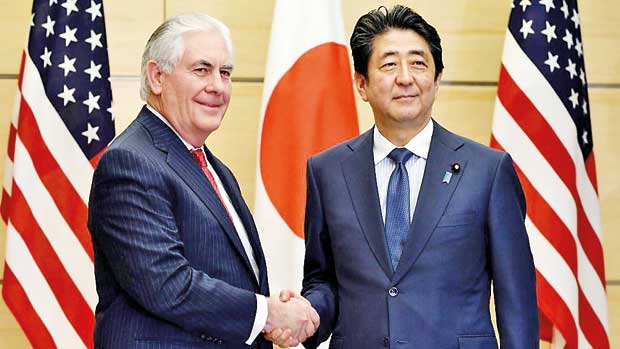Reply To:
Name - Reply Comment
Last Updated : 2024-04-19 11:38:00
Sri Lanka’s local political narrative last week revolved around the plight of the Sri Lanka crew on board the oil tanker Aries 13 and its three-day ordeal under Somali hijackers. The hijacking brought back into the limelight a debate around maritime security, piracy and the best practices of merchant  ships when navigating unsafe ocean spaces. While Sri Lankan security experts were debating piracy, many missed the alarming developments in greater Asia with tensions rising between the Two Koreas and equally alarming American response to the situation.
ships when navigating unsafe ocean spaces. While Sri Lankan security experts were debating piracy, many missed the alarming developments in greater Asia with tensions rising between the Two Koreas and equally alarming American response to the situation.
The United States started deploying highly-advanced missile defence systems such as the Terminal High Altitude Area defence, commonly known as THAAD in South Korea, as a response to North Korean missile tests. The Chinese were vocally against such deployments, claiming it would create further concerns in the Asian security theatre. With North Korea increasing its missile tests, there is a launching of a military satellite that Americans fear can help North Korean long-range missiles be guided to American West Coast targets. The US started deploying its armed Grey Eagle drones, an advanced version of the notorious Predator drones, to carry out surveillance across the North and South Korean border. The drones will be permanently stationed in South Korea.
 The new US Secretary of State Rex Tillerson during his inaugural visit to Asia pictured with Japanese Prime Minister Shinzo Abe...
The new US Secretary of State Rex Tillerson during his inaugural visit to Asia pictured with Japanese Prime Minister Shinzo Abe...
The new US Secretary of State Rex Tillerson’s inaugural visit to Asia took place in this backdrop last week, and a few days into his visit, the new Trump administration’s foreign policy direction became quite apparent. Secretary Tillerson immediately claimed that diplomacy had failed to stop North Korea from expanding its nuclear and non-nuclear missile programme and hence US would even go to the extent of nuclearizing its allies. Such statements are already sending shock waves across the region.
The region is already undergoing clear strategic competition among China, India and Japan, and clear formation of security groupings among other nations. Such cavalier stances by the US may upset the delicate balance that the region has maintained. China finds North Korea a challenge and wants to denuclearize, but not destabilize it. Thus, what America intends to do is in sharp contradiction with China’s policies towards its neighbours.
The column in this backdrop attempts to highlight the emerging militarization of the Asia Pacific, a region with much prosperity. Market booms are descending, resulting in it becoming the most militarized and volatile region in the world. It is unlike any other region, including the Middle East and North Africa. In 2014, the Japanese government started the reinterpretation of the infamous article 9 of its constitution, which prevented Japan from using war as a means of settling international disputes. By 2015, the Japanese legislature (The Diet), approved the Japanese military or self-defence forces (SDF), to provide military materials to external parties. Japan has been aggressively selling military equipment from surface vessels to surveillance equipment to a range of Asian buyers, India being the major buyer of Japanese equipment and a strategic partner.
Japan has accelerated its naval build-up by producing naval assets at unprecedented rates and its first major warship since the Second World War. JS Izumo, commissioned in 2013, is in a new class of ships called a helicopter destroyer, which carries helicopters specializing in anti-submarine warfare. A few weeks ago, Japan dispatched JS Izumo during a major regional visit to patrol the South China sea, while visiting ports in Singapore, the Philippines, Indonesia and Sri Lanka. It will then join the Indian and United States navies in the Malabar exercises.
The Malabar military exercises originally conceived between the USA and India has had a heightened focus since the rise of intense strategic rivalries between the Indian and Chinese militaries, as well as American efforts to remain the key player in the region. Since 2015, Japan has become a key member state, making the exercises a firm trilateral strategic initiative. Its importance and relevance is increasing rapidly, with many Indian security experts and scholars raising the issue of widening submarine deployment by China and the need to counter such moves.
This year’s exercises have focused heavily on Anti-Submarine warfare sending a clear signal to Beijing about Indian, American and Japanese intent to counter any threats emerging from the rapidly-expanding submarine fleet of the PLAN. Japanese deployment of its premier Heli-carrier JS Izumo which specializes in anti-submarine warfare is symbolic of the shift in foreign and security policies undertaken by the Abe administration. The Malabar exercises signal the strategic acknowledgement of the connectivity in the Indo-Pacific oceans and the integration of the Asian geo-strategic sphere into a seamless entity without bifurcating between the Indian and Pacific oceans.
The Sri Lankan perspective of maritime issues have been at the heart of the strategic inclinations that have shaped Sri Lankan political and economic policies over the centuries. We have been blessed with a strategic location. Scholars, historians and analysts all concur on this strategic importance; but at the same time we are challenged by the current developments in the Indo-Pacific and need to make extremely calculated choices on how to engage with the changing realities and narratives of the ocean system which surrounds us.
The key claim in geopolitics is that our location shapes our political and strategic realities. We are already within the nuclear-strike spheres of India, Pakistan and China. With the intense militarization of the Indo-Pacific and the deployment of Nuclear Ballistic missile submarines by China and soon India, the nuclear race will be a key concern for our island nation. Our maritime security perspective is heavily influenced by our economic priorities. Yet, we should take diplomacy into account, in the age of combustible Asian geo-politics.
The America-first foreign policy of the Trump administration points to fewer American commitments globally. The projection of Asia with less US involvement affects the strategic calculations of Japan, Vietnam, Singapore and Australia, as these countries once viewed the American presence as a  stabilizer and deterrent against a possible flaring-up of tensions. To limit American presence and then arm countries with weapons capable of signature strikes would put the region in a tinder box.
stabilizer and deterrent against a possible flaring-up of tensions. To limit American presence and then arm countries with weapons capable of signature strikes would put the region in a tinder box.
The Trump administration released its first budget proposal last week, which saw massive cuts in the US State department budget, while committing nearly 54 billion dollars to US defence spending. These budgetary cuts will affect global governance mechanisms, such as the UN and the World Bank. Such withdrawals or intent to withdraw directly weakens the ability for global governance mechanisms to maintain capabilities to support global stability when it is needed most.
According to the Stockholm Institute of Peace Research (SIPRI), the final half of this decade has seen a significant increase in the military spending of Asian and Oceanic region states. The last two years in particular have seen a massive growth in military modernization efforts in countries including China, India, Indonesia, Singapore, Australia, Japan and Malaysia. Submarines, missiles and air power assets have topped the list in all the nations mentioned above.
Asia’s arms imports topped 43% of the total imports in a region that has no ongoing conflict or civil war. When compared with North or Central Africa and the Middle East, this is a staggering figure. While the world’s most advanced democracy is the main exporter of arms, the largest democracy, India, is the mega buyer. India’s arms imports during the last four years accounted for 13% of all arms imports in the world. China has been shopping around for extremely sophisticated weaponry from Russia and expanding its indigenous arms industry.
The foreign policy imperative of Sri Lanka should be clearly designed and deployed wisely, as it is vital for us to engage and make deeper connections with key players in the region. With SAARC almost defunct and non-firing, we need to create alternative relations, either on a bi-lateral or a multi- lateral basis. Sri Lanka’s future prosperity and stability is dependent on how well we reap the benefits of the Asian century. We should also have political insights into possible fault lines that may engulf the region-and make sure that the relationships we develop are multiple and diverse and not limited to one major power or security grouping-thus giving us the flexibility to be connected to the region even if some areas descend into conflict and violence.

Add comment
Comments will be edited (grammar, spelling and slang) and authorized at the discretion of Daily Mirror online. The website also has the right not to publish selected comments.
Reply To:
Name - Reply Comment
On March 26, a couple arriving from Thailand was arrested with 88 live animal
According to villagers from Naula-Moragolla out of 105 families 80 can afford
Is the situation in Sri Lanka so grim that locals harbour hope that they coul
A recent post on social media revealed that three purple-faced langurs near t

6 minute ago
16 Apr 2024
10 Apr 2024